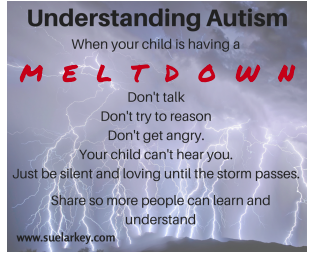 Recognising and managing meltdowns and tantrums is vital to support people with autism. Every student with autism will experience very individual symptoms that are unique to them. Not all individuals with autism will experience a “meltdown” and instead may “shut down.” It is very important you are familiar with each child’s triggers and responses.
Recognising and managing meltdowns and tantrums is vital to support people with autism. Every student with autism will experience very individual symptoms that are unique to them. Not all individuals with autism will experience a “meltdown” and instead may “shut down.” It is very important you are familiar with each child’s triggers and responses.- What is a Meltdown?
- 17 Common Causes of Meltdowns
- 7 Key Difference between Meltdown & Tantrum
- What to do with a Meltdown / Shutdown
A Meltdown is not a Tantrum
Recognising and managing meltdowns and tantrums is vital to support people with autism. Every child with autism will experience very individual symptoms that are unique to them. Not all individuals with ASD will experience a “meltdown” and instead may “shut down.” It is very important you are familiar with each child’s triggers and responses.
The book From Anxiety to Meltdown by Deborah Lipsky is full of insight, information, strategies and more. It will give you the keys to differentiating between a meltdown and tantrum, and more importantly how to deal with them effectively. Below are some great excerpts from the book.
“Meltdowns and catastrophic reactions are involuntary responses while tantrums are purposeful manipulations of behaviour to achieve an intended end result. Whereas meltdowns are an unconscious reaction, tantrums are a voluntary choice. Understanding the difference between a meltdown and tantrum is critical because the interventions are completely opposite, and using the wrong strategy will only worsen the situation in both cases.” (pg 108)
“Meltdowns are extreme emotional and/or behavioural responses to a stressful situation. They are always involuntary. Meltdowns come from prolonged exposure to sensory triggers or cognitive overload without a chance to get away from the overwhelming stimulation. Usually there will be signs of increasing frustration with accompanying anxiety that slowly starts to escalate if the situation is ignored. Catastrophic reactions on the other hand are explosive immediate involuntary reactions to something having gone off script or not according to plan. One moment the individual is content and the very next completely out of control with no forewarning of such an intense reaction.” (pg 112, 113)
What Causes a Meltdown? (pg 187)
1.Sudden abrupt changes (novel situations).
2.Transitions.
3.Sensory overload.
4.Cognitive overload.
5.Being given too many choices at once.
6.Vague or unclear instructions and/or commands.
7.Being asked open ended questions that are too broad.
8.Being forced to be in a prolonged stressful environment.
9.Being in a stressful setting or situations without anycalming tools.
10. Being given an unrealistic task that exceeds capabilities orlimitations.
11. Going to or being the centre of a surprise party.
12. Crowded places and/or events and activities with a highnoise level.
13. Being rushed or hurried to do or finish something.
14. Miscommunications:
a)not understanding the meaning of a metaphor
b)not using concrete, precise, and literal language
c)not getting understandable answers to questions
d)using literal timeframes in a way open tointerpretation, such as wait a minute.
15. Being given a time limit.
16. Going off script.
17. Being forced to socialise during lunch periods at school.
What is the difference between a Meltdown and a Tantrum? (Adapted from pg 140, 141)
Tantrums are a conscious deliberate choice to behave acertain way to manipulate others.
In a tantrum the physical movements are controlled andeasily altered to achieve a desired outcome – i.e.aggression towards a specific individual.
A tantrum can stop instantly at any time.
Tantrums act as defiance.
In a tantrum they may try to bargain.
In a tantrum the individual has excellent recall of theepisode with little or no physical exhaustion.
Please note a tantrum can develop into a meltdown.
What to do with a Meltdown
To effectively deal with meltdowns you must be proactive and not reactive. Identifying the child’s anxiety and its cause is your starting point. Then try to calm the child as this will reduce the chances of a full-blown meltdown. The book offers a range of great strategies to help calm from solitude to reassurance. Once the meltdown has started all you can do is make sure everyone is safe, reduce stimulation levels and if possible address the problem at hand. PLEASE never attempt to restrain a child with ASD from self-harm during a meltdown. They will only fight against your attempts and increase the intensity of self-aggression and aggression towards you! It is too late to stop the meltdown – simply let the meltdown take its course. (Read more on pg 219 “How to control such behaviour in a safe manner without restraint?”)
———————————————————————————–
This book is clear, insightful and practical.A MUST have for every school and family.
5 Star Rating
One of my favourite books to understand Meltdowns!From Anxiety to Meltdown: By Deborah Lipsky Anxiety is the root cause of many of the difficulties experienced by people on the autism spectrum, and is often caused by things such as a change in routine or sensory overload. Deborah Lipsky takes a practical look at what happens when things spiral out of control, exploring what leads to meltdowns and tantrums, and what can be done to help. |

